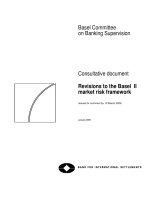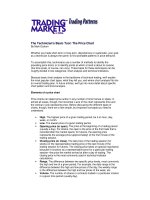CMT Chartered Market Technician Level 2
Bạn đang xem bản rút gọn của tài liệu. Xem và tải ngay bản đầy đủ của tài liệu tại đây (18.64 MB, 1,411 trang )
CMT LEVEL II
2
Theory and Analysis
Readings Selected by
The Market Technicians Association
3
Cover design: Wiley
Copyright © 2016 by The M arket Technicians Association, except as follows:
Perry J. Kaufman, Trading Systems and Methods, + Website, 5th edition (Hoboken, New Jersey: John Wiley & Sons, 2013),
Chapter 3, pages 267–296, 309–330, 350–411, 485–496, 516–559, 1027–1059. Copyright © 2013 by Perry J. Kaufman.
Reprinted with permission.
Russell Rhoads, Trading VIX Derivatives: Trading and Hedging Strategies Using VIX Futures, Options, and Exchange
Traded Notes (Hoboken, New Jersey: John Wiley & Sons, 2007), Chapters 1–2. Copyright © 2007 by Russell Rhoads.
Reprinted with permission.
M arkos Katsanos, Intermarket Trading Strategies (Hoboken, New Jersey: John Wiley & Sons, 2008), Chapters 1–3.
Copyright © 2008 by M ark Katsanos. Reprinted with permission.
Ned Davis, Being Right or Making Money, 3rd edition (Hoboken, New Jersey: John Wiley & Sons, 2014), Chapter 3–4.
Copyright © 2014 by Ned Davis. Reprinted with permission.
Robert A. Weigand, Applied Equity Analysis and Portfolio M anagement (Hoboken, New Jersey: John Wiley & Sons, 2014),
Chapter 1. Copyright © 2014 by Robert A. Weigand. Reprinted with permission.
Thomas N. Bulkowski, Visual Guide to Chart Patterns (Hoboken, New Jersey: John Wiley & Sons, 2012), Chapters 1–17.
Copyright © 2012 by Thomas N. Bulkowski. Reprinted with permission.
Dr. Alexander Elder, The New Trading for a Living (Hoboken, New Jersey: John Wiley & Sons, 2014), Part 6, Chapters 21–
37. Copyright © 2014 by Alexander Elder. Reprinted with permission.
David Aronson, Evidence-Based Technical Analysis (Hoboken, New Jersey: John Wiley & Sons, 2006), Introduction,
Chapters 3. 7–8. Copyright © 2006 by David Aronson. Reprinted with permission.
Edwin T. Burton and Sunit N. Shah, Behavioral Finance (Hoboken, New Jersey: John Wiley & Sons, 2013), Chapters 9–11.
Copyright © 2013 by Edwin T. Burton and Sunit N. Shah. Reprinted with permission.
M ebane T. Faber, “Relative Strength Strategies for Investing” (El Segundo, CA: Cambria Investment M anagement, 2010).
Copyright © 2010 by M ebane T. Faber. Reprinted with permission.
All rights reserved.
Published by John Wiley & Sons, Inc., Hoboken, New Jersey.
Published simultaneously in Canada.
No part of this publication may be reproduced, stored in a retrieval system, or transmitted in any form or by any means,
electronic, mechanical, photocopying, recording, scanning, or otherwise, except as permitted under Section 107 or 108 of the
1976 United States Copyright Act, without either the prior written permission of
the Publisher, or authorization through payment of the appropriate per-copy fee to the Copyright Clearance Center, Inc., 222
Rosewood Drive, Danvers, M A 01923, (978) 750-8400, fax (978) 646-8600, or on the
Web at www.copyright.com. Requests to the Publisher for permission should be addressed to the Permissions Department,
John Wiley & Sons, Inc., 111 River Street, Hoboken, NJ 07030, (201) 748-6011,
fax (201) 748-6008, or online at />Limit of Liability/Disclaimer of Warranty: While the publisher and author have used their best efforts in preparing this book,
they make no representations or warranties with respect to the accuracy or completeness of the contents of this book and
specifically disclaim any implied warranties of merchantability or fitness for a particular purpose. No warranty may be
created or extended by sales representatives or written sales materials. The advice and strategies contained herein may not be
suitable for your situation. You should consult with a professional where appropriate. Neither the publisher nor author shall
be liable for any loss of profit or any other commercial damages, including but not limited to special, incidental,
consequential, or other damages.
For general information on our other products and services or for technical support, please contact our Customer Care
Department within the United States at (800) 762-2974, outside the United States at
(317) 572-3993 or fax (317) 572-4002.
Wiley publishes in a variety of print and electronic formats and by print-on-demand. Some material included with standard
print versions of this book may not be included in e-books or in print-on-demand. If this book refers to media such as a CD
or DVD that is not included in the version you purchased, you may download this material at .
For more information about Wiley products, visit www.wiley.com.
ISBN 978-1-119-22270-5 (Paperback)
4
ISBN 978-1-119-25141-5 (ePub)
5
CONTENTS
1. ABOUT THE MARKET TECHNICIANS ASSOCIATION
2. WHAT IS THE CMT® PROGRAM?
1. What Will You Learn?
3. HOW THIS BOOK WAS CREATED
4. PREFACE
1. Exam Topics & Question Weightings
5. Chapter 1: Charting
1. Finding Consistent Patterns
2. What Causes the Major Price Moves and Trends?
3. The Bar Chart and Its Interpretation by Charles Dow
4. Chart Formations
5. Trendlines
6. One-Day Patterns
7. Continuation Patterns
8. Basic Concepts in Chart Trading
9. Accumulation and Distribution—Bottoms and Tops
10. Episodic Patterns
11. Price Objectives for Bar Charting
12. Implied Strategies in Candlestick Charts
13. Practical Use of the Bar Chart
14. Evolution in Price Patterns
15. Notes
6. Chapter 2: Understanding Implied Volatility
1. Historical Versus Forward-Looking Volatility
2. Put-Call Parity
3. Estimating Price Movement
4. Valuing Options: Pricing Calculators and Other Tools
5. Fluctuations Based on Supply and Demand
6
7.
8.
9.
10.
11.
12.
6. The Impact on Option Prices
7. Implied Volatility and the VIX
Chapter 3: About the VIX Index
1. History of the VIX
2. Calculating the VIX
3. The VIX and Put-Call Parity
4. The VIX and Market Movement
5. Equity Market Volatility Indexes
6. Amex QQQ Volatility Index
Chapter 4: Intermarket Analysis
1. 4.1 Determining Intermarket Relations
2. 4.2 Using Intermarket Correlations for Portfolio Diversification
Chapter 5: Correlation
1. 5.1 The Correlation Coefficient
2. 5.2 Assumptions
3. 5.3 Outliers
4. 5.4 Homoscedasticity
Chapter 6: Regression
1. 6.1 The Regression Equation
2. 6.2 Multiple Regression
3. 6.3 Assumptions
4. 6.4 Nonparametric Regression
Chapter 7: Regression Analysis
1. ARIMA
2. Basic Trading Signals Using a Linear Regression Model
3. Measuring Market Strength
4. Notes
Chapter 8: Time-Based Trend Calculations
1. Forecasting and Following
2. Price Change over Time
3. The Moving Average
4. Geometric Moving Average
5. Accumulative Average
7
13.
14.
15.
16.
6. Reset Accumulative Average
7. Drop-Off Effect
8. Notes
Chapter 9: Trend Systems (Part 1)
1. Why Trend Systems Work
2. Basic Buy and Sell Signals
3. Bands and Channels
4. Applications of a Single Trend
5. Notes
Chapter 10: Trend Systems (Part 2)
1. Techniques Using Two Trendlines
2. Multiple Trends and Common Sense
3. Comprehensive Studies
4. Selecting the Right Trend Method and Speed
5. Moving Average Sequences: Signal Progression
6. Early Exits from a Trend
7. Moving Average Projected Crossovers
8. Notes
Chapter 11: Momentum and Oscillators
1. Momentum
2. Divergence Index
3. Oscillators
4. Double-Smoothed Momentum
5. Notes
Chapter 12: Cycle Analysis
1. Cycle Basics
2. Uncovering the Cycle
3. Cycle Channel Index
4. Short Cycle Indicator
5. Phasing
6. A Special Case for Futures Volume
7. Variations from the Normal Patterns
8. Standard Interpretation
8
9. Volume Indicators
10. Breadth Indicators
11. Interpreting Volume and Breadth Systematically
12. An Integrated Probability Model
13. Notes
17. Chapter 13: Volume, Open Interest, and Breadth
1. A Special Case for Futures Volume
2. Variations from the Normal Patterns
3. Standard Interpretation
4. Volume Indicators
5. Breadth Indicators
6. Interpreting Volume and Breadth Systematically
7. An Integrated Probability Model
8. Intraday Volume Patterns
9. Filtering Low Volume
10. Market Facilitation Index
11. Notes
18. Chapter 14: A Stock Market Model
1. A Stock Market Model
2. Overview of the Fab Five
3. Tape Component
4. The Final Tape Component
5. The Sentiment Component
6. Sentiment Summary
7. The Monetary Component
8. Monetary Component Summary
9. Fab Five Combo Component
10. Combo Model Summary
11. Summing Up the Fab Five
12. How We Use the Fab Five
19. Chapter 15: A Simple Model for Bonds
1. A Slight Modification
2. Summary
9
20. Chapter 16: Perspectives on Active and Passive Money Management
1. Terminology: Investors, Investment Vehicles, Risk and Return
2. The Top-Down Fundamental Analysis Process
3. The Record of Professional Money Managers
4. Market Efficiency, Behavioral Finance, and Adaptive
Expectations
5. Additional Perspectives on Investing
6. Professional Investment Policy Statements
7. Summary
8. References
9. Notes
21. Chapter 17: Understanding Chart Patterns
1. The Basics
2. Pattern Recognition Made Easy
3. Minor Highs and Lows
4. Trendlines
22. Chapter 18: Understanding Chart Pattern Breaks
1. Support and Resistance
2. Gaps
3. Throwbacks and Pullbacks
23. Chapter 19: Triangles, Pennants, and Flags
1. Pattern Identification
2. Rectangles
3. Ascending Triangles
4. Descending Triangles
5. Symmetrical Triangles
6. Flags and Pennants
24. Chapter 20: Tops and Bottoms
1. Double Bottoms
2. Triple Bottoms
3. Double Tops
4. Triple Tops
25. Chapter 21: Head-and-Shoulders Patterns
10
26.
27.
28.
29.
1. Head-and-Shoulders Bottoms
2. Head-and-Shoulders Tops
Chapter 22: Computers in Trading
1. Toolboxes
2. Black Boxes and Gray Boxes
3. Computers
4. Market Data
5. Three Major Groups of Indicators
6. Note
Chapter 23: Moving Averages
1. Twice as Much Bark
2. Market Psychology
3. Exponential Moving Averages
4. Choosing the Length of a Moving Average
5. Trading Rules
6. More on Moving Averages
7. Dual EMAs
8. Moving Averages and Channels
9. Prices, Values, and the Value Zone
10. Note
Chapter 24: Moving Average Convergence-Divergence: MACD Lines
and MACD-Histogram
1. How to Create MACD
2. MACD-Histogram
3. Divergences
4. The Hound of the Baskervilles
5. Note
Chapter 25: The Directional System
1. How to Construct the Directional System
2. Crowd Behavior
3. Trading Rules
4. Average True Range—Help from Volatility
5. Note
11
30. Chapter 26: Oscillators
1. Overbought and Oversold
2. Note
31. Chapter 27: Stochastic
1. Crowd Psychology
2. Trading Rules
3. More on Stochastic
4. Note
32. Chapter 28: Relative Strength Index
1. Mass Psychology
2. Trading Rules
3. Note
33. Chapter 29: Volume
1. Crowd Psychology
2. Trading Pointers
3. Note
34. Chapter 30: Volume-Based Indicators
1. On-Balance Volume
2. Crowd Psychology
3. Trading Signals
4. More on OBV
5. Accumulation/Distribution
6. Crowd Behavior
7. Trading Rules
8. More on Accumulation/Distribution
9. Notes
35. Chapter 31: Force Index
1. How to Construct Force Index
2. Trading Psychology
3. Trading Rules
4. Notes
36. Chapter 32: Open Interest
1. Crowd Psychology
12
37.
38.
39.
40.
41.
42.
2. Trading Rules
3. More on Open Interest
4. Note
Chapter 33: Time
1. Cycles
2. Indicator Seasons
3. Market Time
4. The Factor of Five
5. Notes
Chapter 34: Trading Timeframes
1. Investing
2. Swing Trading
3. Day-Trading
4. Note
Chapter 35: The New High–New Low Index
1. How to Construct NH-NL
2. Crowd Psychology
3. Trading Rules for NH-NL
4. NH-NL in Multiple Timeframes and Look-Back Periods
5. Notes
Chapter 36: Stocks above 50-Day MA
1. Note
Chapter 37: Other Stock Market Indicators
1. Advance/Decline
2. Note
Chapter 38: Consensus and Commitment Indicators
1. Tracking Advisory Opinion
2. Signals from the Press
3. Signals from Advertisers
4. Commitments of Futures Traders
5. Legal Insider Trading
6. Short Interest
7. Notes
13
43. Chapter 39: The Scientific Method and Technical Analysis
1. The Most Important Knowledge of All: A Method to Get More
2. The Legacy of Greek Science: A Mixed Blessing
3. The Birth of the Scientific Revolution
4. Faith in Objective Reality and Objective Observations
5. The Nature of Scientific Knowledge
6. The Role of Logic in Science
7. The Philosophy of Science
8. The End Result: The Hypothetico-Deductive Method
9. Rigorous and Critical Analysis of Observed Results
10. Summary of Key Aspects of the Scientific Method
11. If TA Were to Adopt the Scientific Method
12. Objectification of Subjective TA: An Example
13. Subsets of TA
14. Notes
44. Chapter 40: Theories of Nonrandom Price Motion
1. The Importance of Theory
2. Scientific Theories
3. What Is Wrong with Popular TA Theory?
4. The Enemy's Position: Efficient Markets and Random Walks
5. Challenging EMH
6. Behavioral Finance: A Theory of Nonrandom Price Motion
7. Nonrandom Price Motion in the Context of Efficient Markets
8. Conclusion
9. Notes
45. Chapter 41: Case Study of Rule Data Mining for the S&P 500
1. Data Mining Bias and Rule Evaluation
2. Avoidance of Data Snooping Bias
3. Analyzed Data Series
4. Technical Analysis Themes
5. Performance Statistic: Average Return
6. No Complex Rules Were Evaluated
7. The Case Study Defined in Statistical Terms
14
46.
47.
48.
49.
8. Rules: Transforming Data Series into Market Positions
9. Time-Series Operators
10. Input Series to Rules: Raw Time Series and Indicators
11. Table of 40 Input Series Used in Case Study
12. The Rules
13. Notes
Chapter 42: Prospect Theory
1. The Reference Point
2. The S-Curve
3. Loss Aversion
4. Prospect Theory in Practice
5. Drawbacks of Prospect Theory
6. Conclusion
7. Notes
Chapter 43: Perception Biases
1. Saliency
2. Framing
3. Anchoring
4. Sunk-Cost Bias
5. Conclusion
6. Notes
Chapter 44: Inertial Effects
1. Endowment Effect
2. Status Quo Effect
3. Disposition Effect
4. Conclusion
5. Notes
Chapter 45: Relative Strength Strategies for Investing
1. Abstract
2. Momentum
3. Data
4. Sector Returns
5. BUY RULE
15
6. SELL RULE
7. Solutions to the Drawbacks of Relative Strength Systems
8. Real-World Implementation
9. Conclusion
10. Appendix A - Data Sources
50. Chapter 46: Risk Control
1. Mistaking Luck for Skill
2. Risk Aversion
3. Liquidity
4. Measuring Return and Risk
5. Leverage
6. Leverage Based on Exposure
7. Individual Trade Risk
8. Kaufman on Stops and Profit-Taking
9. Ranking of Markets for Selection
10. Probability of Success and Ruin
11. Entering a Position
12. Compounding a Position
13. Equity Trends
14. Investing and Reinvesting: Optimal f
15. Comparing Expected and Actual Results
16. Notes
51. End User License Agreement
16
List of Tables
1. Chapter 2
1. TABLE 2.1
2. TABLE 2.2
3. TABLE 2.3
4. TABLE 2.4
5. TABLE 2.5
6. TABLE 2.6
7. TABLE 2.7
8. TABLE 2.8
2. Chapter 3
1. TABLE 3.1
2. TABLE 3.2
3. TABLE 3.3
4. TABLE 3.4
5. TABLE 3.5
6. TABLE 3.6
7. TABLE 3.7
8. TABLE 3.8
9. TABLE 3.9
10. TABLE 3.10
11. TABLE 3.11
3. Chapter 4
1. TABLE 4.1
2. TABLE 4.2
3. TABLE 4.3
4. Chapter 5
1. TABLE 5.1
17
2. TABLE 5.2
3. TABLE 5.3
5. Chapter 6
1. TABLE 6.1
2. TABLE 6.2
3. TABLE 6.3
6. Chapter 8
1. TABLE 8.1
2. TABLE 8.2
7. Chapter 9
1. TABLE 9.1
2. TABLE 9.2
3. TABLE 9.3
4. TABLE 9.4
5. TABLE 9.5
6. TABLE 9.6
8. Chapter 10
1. TABLE 10.1
2. TABLE 10.2
3. TABLE 10.3
4. TABLE 10.4
5. TABLE 10.5
6. TABLE 10.6
9. Chapter 11
1. TABLE 11.1
2. TABLE 11.2
3. TABLE 11.3
10. Chapter 12
1. TABLE 12.1
2. TABLE 12.2
18
3. TABLE 12.3
4. TABLE 12.4
5. TABLE 12.5
6. TABLE 12.6
11. Chapter 13
1. TABLE 13.1
2. TABLE 13.2
3. TABLE 13.3
12. Chapter 46
1. TABLE 46.1
2. TABLE 46.2
3. TABLE 46.3
4. TABLE 46.4
5. TABLE 46.5
6. TABLE 46.6
7. TABLE 46.7
8. TABLE 46.8
9. TABLE 46.9
10. TABLE 46.10
11. TABLE 46.11
12. TABLE 46.12
13. TABLE 46.13
14. TABLE 46.14
15. TABLE 46.15
16. TABLE 46.16
19
List of Illustrations
1. Chapter 1
1. FIGURE 1.1 Dow Industrial, Utilities, and Transportation
Indexes, 1991–2010. Dow originally created the industrial and
railway averages to hide the large, erratic price moves caused by
price manipulation and lack of liquidity. Dow Theory has been
adapted to use the current versions of the major indexes, the
Industrials (top panel), the Utilities (center panel), and the
Transportation Index (bottom panel). Although these indexes
represent different aspects of the economy, they have become
highly correlated.
2. FIGURE 1.2 Bull and Bear Market Signals Are Traditional
Breakout Signals, but on a Larger Scale.
3. FIGURE 1.3 NASDAQ from April 1998 through June 2002. A
clear example of a bull and bear market with a classic pattern of
volume.
4. FIGURE 1.4 Secondary Trends and Reactions. A reaction is a
smaller swing in prices that ends when a new high reinstates the
bull market.
5. FIGURE 1.5 Dow Theory Applied to the S&P. Most of Dow's
principles apply to the current marketplace, but some experience
and interpretation is necessary.
6. FIGURE 1.6 The Trend Is Easier to See after It Has Occurred.
While the upwards trend is clear, are prices going to continue
higher, or is this the end of the trend?
7. FIGURE 1.7 Upwards and Downwards Trendlines Applied to
Intel, November 2002 through May 2003.
8. FIGURE 1.8 Horizontal Support and Resistance Lines Shown on
Gold Futures Prices.
9. FIGURE 1.9 Basic Sell and Buy Signals using Trendlines.
10. FIGURE 1.10 Trading Rules for Horizontal Support and
Resistance Lines.
11. FIGURE 1.11 Trading a Price Channel. Once the channel has been
drawn, buying is done near the support line and selling near the
20
resistance line.
12. FIGURE 1.12 Turning from an Upward to a Downward Channel.
Trades are always entered in the direction of the trend.
13. FIGURE 1.13 Price Gaps Shown on a Chart of Amazon.com.
14. FIGURE 1.14 A Series of Spikes in Bonds. From June through
October 2002, U.S. bonds show three spikes that represent local
tops. The spikes represent clear resistance levels that cause a
unique pattern in the upwards move.
15. FIGURE 1.15 AMR in Early 2003 Showing a Classic Island
Reversal with Examples of Other One-Day Patterns.
16. FIGURE 1.16 Russell 2000 during the Last Half of 2002 Showing
Reversal Days, Key Reversal Days, Inside Days, and Outside
Days.
17. FIGURE 1.17 Wide-Ranging Days, Outside Days, and Inside
Days for Tyco.
18. FIGURE 1.18 Symmetric and Descending Triangles and a
Developing Bear Market in Gold Futures.
19. FIGURE 1.19 An Assortment of Continuation Patterns. These
patterns are all resolved by prices moving lower. A downward
pennant can be found in the middle of the chart.
20. FIGURE 1.20 Wedge. A weaker wedge formation is followed by
a strong rising wedge near the end of 1999 in this chart of General
Electric.
21. FIGURE 1.21 A V-top in the NASDAQ Index, March 2000.
22. FIGURE 1.22 Cash Cotton Prices Showing V-Top in Early 2011.
23. FIGURE 1.23 Classic V-Top in Amazon, January 1999, and Two
Other Tops.
24. FIGURE 1.24 Two V-Bottoms in Crude Oil.
25. FIGURE 1.25 A Double Top in Crude Oil.
26. FIGURE 1.26 A Double Bottom in Cisco.
27. FIGURE 1.27 Natural Gas Shows a Classic Triple Top.
28. FIGURE 1.28 An Extended Rectangular Bottom in Crude Oil from
1986 through 1999.
29. FIGURE 1.29 Two Rounded Tops in the German DAX Stock
21
Index.
30. FIGURE 1.30 A Classic Rounded Bottom in the Japanese Yen.
31. FIGURE 1.31 A Large Declining Wedge Followed by an Upside
Breakout in the Japanese Yen.
32. FIGURE 1.32 Head-and-Shoulders Top Pattern in the Japanese
Nikkei Index.
33. FIGURE 1.33 Episodic Pattern Shown in an Upward Price Shock
in Raytheon Following 9/11/2001.
34. FIGURE 1.34 Price Objectives for Consolidation Patterns and
Channels. (a) Two objectives for consolidation patterns. (b) Price
objective for a channel.
35. FIGURE 1.35 Forming New Channels to Determine Objectives.
36. FIGURE 1.36 Head-and-Shoulders Top Price Objective.
37. FIGURE 1.37 Triangle and Flag Objectives. (a) Triangle
objective is based on the width of the initial sides. (b) Flag
objective is equal to the move prior to the flag formation.
38. FIGURE 1.38 Popular Candle Formations.
39. FIGURE 1.39 Similar Patterns in the S&P, GE, and Exxon.
40. FIGURE 1.40 Equity Index Prices for Five Asian Countries.
41. FIGURE 1.41 Asian Equity Index Markets Adjusted to the Same
Volatility Level and Started at the Value 100.
2. Chapter 2
1. FIGURE 2.1 Payout Diagram Comparison.
3. Chapter 3
1. FIGURE 3.1 Payoff Comparison.
4. Chapter 4
1. FIGURE 4.1 Comparison Chart of the S&P 500 (in Bold with the
Scale on the Right Y-axis) and the Yen (USD/JPY) (with the Scale
on the Left Axis) from June 2006 to January 2008.
2. FIGURE 4.2 Weekly Comparison Chart of the S&P 500 (Thick
Line with the Scale on the Right Y-axis), the Nasdaq (in Bold
with the Scale on the Left Axis) and the Greek Athens General
Index (ATG) from 1999 to 2008.
22
3. FIGURE 4.3 Weekly Composite Chart of the S&P 500 (Thick
Line), the CRB Index (Thin Line with the Scale on the Right Yaxis) and US Treasury Bonds (Grey Bar Chart) from 1997 to
2008. Down Arrows Indicate Major Tops in Stocks and Bonds
and Up Arrows Bottoms.
4. FIGURE 4.4 Yearly Correlation Variation Between the S&P 500
and Leading International Indices from 1992–2007. The
Correlation with the DJ-30 Is Depicted by a Black Line, with
Germany's DAX by a Dashed Line, with the FTSE by a Grey
Line, and with the Nikkei by a White Line. Notice the Correlation
Volatility, Especially Before 1996. The Nikkei Had the Weakest
and Most Volatile Correlation with the S&P 500.
5. FIGURE 4.5 Monthly Comparison Chart of the S&P 500 (Bar
Chart with the Scale on the Right Y-axis) and Light Sweet Crude
Oil Futures Continuous Contract (NYMEX:CL) (Line Chart
Below) from January of 1994 to January of 2008. The Equity Line
of a Composite Portfolio Consisting of 70% Equities
(Represented by the S&P 500) and 30% Oil Futures Is Plotted in
the Top Window. The Composite Portfolio Produced Better
Returns with Less Volatility.
5. Chapter 5
1. FIGURE 5.1 Scatterplot of the S&P 500 and the British FTSE
100, for the Last 15-Year Period. The Relationship Is
Approximately Linear, as the Points Fall Generally Along a
Straight Line.
2. FIGURE 5.2 Scatterplot of the S&P 500 and the Nasdaq 100, for
the Last 15-Year Period. The Relationship Is Not Linear, as the
Best Fit Line Is Curvilinear.
3. FIGURE 5.3 Scatterplot of the S&P 500 and the Nikkei, for the
Last 15-Year Period. The Relationship Is Not Linear, as the Points
Deviate Significantly from the Best Fit Line.
4. FIGURE 5.4 Weekly Chart of the S&P 500 (Thick Line) with the
Nasdaq 100 Superimposed (Thin Black Line) from 1990 to 2007.
The Relative Strength between the S&P 500 and the NDX Is
Plotted in the Top Window.
5. FIGURE 5.5 Weekly Composite Chart of the S&P 500 (Thick
Line) with Japan's Nikkei Superimposed (Thin Black Line) from
23
1990 to 2007. The 52-Week Pearson's Correlation Strength
between the S&P 500 and the Nikkei Is Plotted in the Top
Window.
6. FIGURE 5.6 Distribution of S&P 500 Daily % Returns for the 15Year Period from 1992–2006.
7. FIGURE 5.7 Distribution of S&P 500 Daily Prices for the 15Year Period from 1992–2006.
8. FIGURE 5.8 Normality Plot of the S&P 500 15-Year Daily %
Returns.
9. FIGURE 5.9 Distribution of S&P 500 Daily % Returns since the
Elimination of the Uptick Rule (from 9 July 2007 Until 5 May
2008). Notice the Unusually High Frequency of More than –2.5%
Daily Declines During the Relatively Short Period of 210 Trading
Days. The Standard Deviation also Increased by More than 30%
and the Kurtosis (Which Is the Variance Due to Infrequent
Extreme Deviations) Increased by More than 700% from 0.43 to
3.77.
10. FIGURE 5.10 Six Month Scatterplot of the Amex Oil Index (XOI)
vs. Nymex Oil Futures. By Removing Just One Outlier (enclosed
in the square on the far right of the graph), the Correlation
Improved from 0.523 to 0.568.
11. FIGURE 5.11 Fifteen Year Scatterplot of the S&P 500 vs.
Canada's TSX Composite Index. The Plot Shows a Violation of
the Assumption of Homoscedasticity. For Lower Values on the
TSX-Axis, the Points Are All Very Near the Regression Line,
While for Higher Values the Variability Around the Regression
Line Increases Dramatically.
6. Chapter 6
1. FIGURE 6.1 Three-dimensional scatterplot visualizing the
relationship between the S&P 500 (on the Y-axis) vs. the Euro
Stoxx 50 (on the X-axis) and the yen (on the Z-axis) for the 2-year
period from 1 January 2006 to 31 December 2007. The more
points fall inside the regression plane the better the predictive
power of the regression model.
7. Chapter 7
1. FIGURE 7.1 ARIMA Correlograms from Autocorrelations. Lags
shown along the bottom give correlations at the left. None of them
24
are significant (output from ProStat based on gold futures).
2. FIGURE 7.2 ARIMA Forecast Becomes Less Accurate as It Is
Used Further Ahead.
3. FIGURE 7.3 Linear Regression Model. Penetration of the
confidence band turns the trend from up to down. When prices
move steadily up, the regression model will signal a change of
direction faster than a moving average.
4. FIGURE 7.4 IBM Trend Using the Slope and R.
5. FIGURE 7.5 Prices of Four Pharmaceutical Companies, 2010
through January 2011.
6. FIGURE 7.6 Indexed Stocks beginning at 100 Give a Better View
of Relative Performance.
7. FIGURE 7.7 Rolling linear regression slope, using a 60-day
calculation period, shows that each market changes from stronger
to weaker over the 1-year period.
8. Chapter 8
1. FIGURE 8.1 General Electric Price from December 31, 2010,
through February 15, 2011. Forecast accuracy decreases as the
forecast period increases.
2. FIGURE 8.2 A Comparison of Moving Averages. The simple
moving average, linearly weighted average, triangular weighted,
and average off methods are applied to the S&P, April through
December 2010.
3. FIGURE 8.3 S&P continuous futures, April through December
2010, with examples of the simple moving average, standard
deviation average, geometric average, and exponential smoothing,
all with calculation periods of 40 days.
9. Chapter 9
1. FIGURE 9.1 Distribution of Runs. The shaded area shows the
normal distribution of random runs. The solid dark line represents
the distribution when there is a fat tail. In the fat tail distribution,
there are fewer short runs and an unusually large number of longer
runs or a single exceptionally long run.
2. FIGURE 9.2 Frequency Distribution of Returns for S&P Futures
Using a 40-Day Simple Moving Average Strategy. Results show a
25









